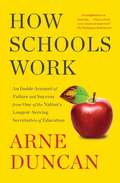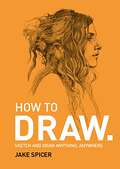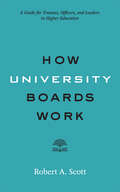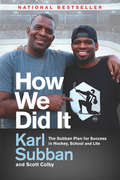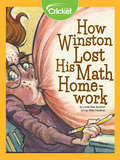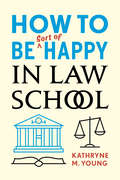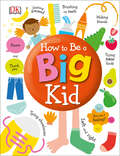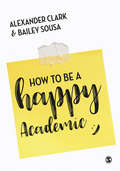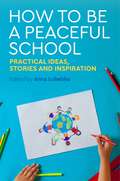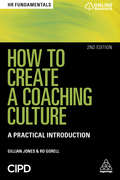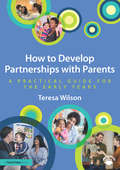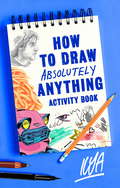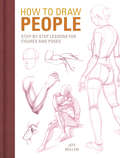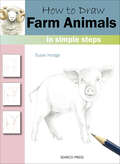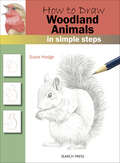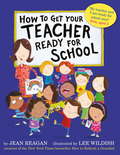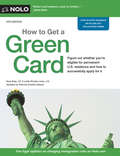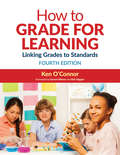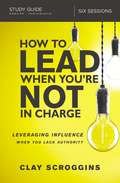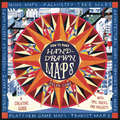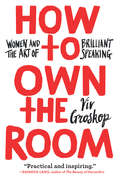- Table View
- List View
How Schools Work: An Inside Account of Failure and Success from One of the Nation's Longest-Serving Secretaries of Education
by Arne DuncanFrom the Secretary of Education under President Obama, an exposé of the status quo that helps maintain a broken system at the expense of our kids’ education.“Education runs on lies. That’s probably not what you’d expect from a former Secretary of Education, but it’s the truth.” So opens Arne Duncan’s How Schools Work, although the title could just as easily be How American Schools Work for Some, Not for Others, and Only Now and Then for Kids. Drawing on nearly three decades in education—from his mother’s after-school program on Chicago’s South Side to his tenure as Secretary of Education in DC—How Schools Work follows Arne (as he insists you call him) as he takes on challenges at every turn: gangbangers in Chicago housing projects, parents who call him racist, teachers who insist they can’t help poor kids, unions that refuse to modernize, Tea Partiers who call him an autocrat, affluent white progressive moms who hate yearly tests, and even the NRA, which once labeled Arne the “most extreme anti-gun member of President Obama's Cabinet.” Going to a child’s funeral every couple of weeks, as he did when he worked in Chicago, will do that to a person. How Schools Work exposes the lies that have caused American kids to fall behind their international peers, from early childhood all the way to college graduation rates. But it also celebrates the countless everyday heroes Arne has encountered along the way: teachers, principals, reformers, staffers, business people, mayors, and presidents. How Schools Work will inspire parents, teachers, voters, and even students to demand more of our public schools. If America is going to be great, then we can accept nothing less.
How To Draw: Sketch and draw anything, anywhere with this inspiring and practical handbook
by Jake SpicerJake Spicer wants you to learn how to draw. This is his complete course in drawing, suitable for complete beginners as well as experienced artists, and designed to help you fit drawing into your lifestyle. Tried-and-tested exercises, ranging from five-minute sketches to dedicated sessions of an hour or longer, cover every subject and location you could wish for, while accessibly written drawing theory helps you relate the technical concepts to your practice, helping you to hone your craft. Whatever your goals are, expert art tutor Jake Spicer gives you the inspiration and encouragement to draw more - and keep improving.
How University Boards Work: A Guide for Trustees, Officers, and Leaders in Higher Education (Higher Ed Leadership Essentials)
by Robert A. ScottAn expert guide designed to help university trustees become effective leaders.Honorable Mention for Eric Hoffer Award (Business Category) by The Hoffer ProjectWe expect college and university trustees to hire the president, advise senior staff, manage investments and financial decisions, and oversee major strategic initiatives. Unfortunately, they sometimes come into this powerful role with little or no understanding of what they are meant to do or how their institutions work.How University Boards Work, by Robert A. Scott, is designed to help trustees understand how to fulfill their responsibilities. Written by a widely respected leader in American higher education and former university president, How University Boards Work is the product of personal experience and considerable research. This concise, straightforward guide includes:• an explanation of the difference between governance and management• tips on how best to prepare for board decisions and discussions• examples of positive and negative board behavior• guidance about board professional development• advice on managing transitions between chief executivesHow University Boards Work will prove an invaluable resource for those responsible for governing colleges and universities, whether privately financed or state funded. It will also be an illuminating read for board secretaries, campus executives and administrators, faculty leaders, alumni volunteers, and public officials, as well as anybody seeking to understand institutional governance in the light of past and current trends in higher education.
How We Did It: The Subban Plan for Success in Hockey, School and Life
by Karl Subban Scott ColbyThe ultimate hockey dad, Karl Subban is a former school principal and father of five, including three sons--P.K., Malcolm and Jordan--who have been drafted to the NHL. Karl's inspirational and moving story follows the hockey journey from house league to the big leagues and shows how to grow the unlimited potential that is in every child.In his thirty-plus years of coaching, teaching and parenting, Karl Subban has proved to be a leader with the gift of inspiring others. He has dedicated his life to helping young people grow their potential--to be better at what they do, and to be better people. Originally from Jamaica, Karl Subban, along with his wife, Maria, have raised five accomplished children. Their oldest son is P.K. Subban, who won the Norris trophy for top defenceman in the NHL and whose trade from the Canadiens to the Nashville Predators shocked the hockey world. Their two daughters are teachers, one a university basketball star and the other a talented visual artist. Their two youngest sons, Malcolm and Jordan, have been drafted and signed by the Bruins and the Canucks. As a child, Karl dreamed of being a star cricket player--but when he moved to Canada at age 12, hockey and basketball became his new passions. At university, when he realized his NBA hoop dreams would not come to be, Subban found his true destiny as an educator, devoting his life to bringing out the best in his students and his children. From the backyard hockey rink to the nail-biting suspense of draft days, Karl Subban shares tales of his family's unique hockey journey. Mixing personal stories with lessons he learned as a coach and principal--lessons about goal-setting, perseverance and accomplishment--How We Did It will allow other parents, teachers, coaches and mentors to apply the same principles as they help the young people in their lives to identify, develop and live their dreams.
How Winston Lost His Math Homework
by Matt Faulkner Linda Rae ApolzonWinston is in trouble. He didn’t bring his math homework to school, and his teacher isn’t happy! It wasn’t his fault, though. He’d been chewing bubblegum and blowing bubbles, and one of his bubbles goes on an adventure—and takes his homework with it!
How to Be Sort of Happy in Law School
by Kathryne M. YoungEach year, over 40,000 new students enter America's law schools. Each new crop experiences startlingly high rates of depression, anxiety, fatigue, and dissatisfaction. Kathryne M. Young was one of those disgruntled law students. After finishing law school (and a PhD), she set out to learn more about the law school experience and how to improve it for future students. Young conducted one of the most ambitious studies of law students ever undertaken, charting the experiences of over 1000 law students from over 100 different law schools, along with hundreds of alumni, dropouts, law professors, and more. How to Be Sort of Happy in Law School is smart, compelling, and highly readable. Combining her own observations and experiences with the results of her study and the latest sociological research on law schools, Young offers a very different take from previous books about law school survival. Instead of assuming her readers should all aspire to law-review-and-big-firm notions of success, Young teaches students how to approach law school on their own terms: how to tune out the drumbeat of oppressive expectations and conventional wisdom to create a new breed of law school experience altogether. Young provides readers with practical tools for finding focus, happiness, and a sense of purpose while facing the seemingly endless onslaught of problems law school presents daily. This book is an indispensable companion for today's law students, prospective law students, and anyone who cares about making law students' lives better. Bursting with warmth, realism, and a touch of firebrand wit, How to Be Sort of Happy in Law School equips law students with much-needed wisdom for thriving during those three crucial years.
How to Be a Big Kid
by DKThis super-handy book is a survival guide for the busiest job there is: being a preschoolerBeing little is hard work. There's so much for children to learn: tying their shoelaces, finding the right hole for each arm in a sweater, remembering to say "please" and "thank you," sharing toys with other children, and a whole bunch of other things, too. Then they're expected to go to school and learn even more. How to be a Big Kid is here to help children learn the skills they need to take care of themselves, get along with others, and be ready to go on their first day of school.
How to Be a Happy Academic: A Guide to Being Effective in Research, Writing and Teaching
by Alexander Clark Bailey SousaWant to be an effective, successful and happy academic? This book helps you hone your skills, showcase your strengths, and manage all the professional aspects of academic life. With their focus on life-long learning and positive reflection, Alex and Bailey encourage you to focus on your own behaviours and personal challenges and help you to find real world solutions to your problems or concerns. Weaving inspirational stories, the best of research and theory, along with pragmatic advice from successful academics, this book provides step-by-step guidance and simple tools to help you better meet the demands of modern academia, including: Optimising your effectiveness, priorities & strategy Workflow & managing workload Interpersonal relationships, and how to influence Developing your writing, presenting and teaching skills Getting your work/life balance right. Clear, practical and refreshingly positive this book inspires you to build the career you want in academia.
How to Be a Happy Academic: A Guide to Being Effective in Research, Writing and Teaching
by Alexander Clark Bailey SousaWant to be an effective, successful and happy academic? This book helps you hone your skills, showcase your strengths, and manage all the professional aspects of academic life. With their focus on life-long learning and positive reflection, Alex and Bailey encourage you to focus on your own behaviours and personal challenges and help you to find real world solutions to your problems or concerns. Weaving inspirational stories, the best of research and theory, along with pragmatic advice from successful academics, this book provides step-by-step guidance and simple tools to help you better meet the demands of modern academia, including: Optimising your effectiveness, priorities & strategy Workflow & managing workload Interpersonal relationships, and how to influence Developing your writing, presenting and teaching skills Getting your work/life balance right. Clear, practical and refreshingly positive this book inspires you to build the career you want in academia.
How to Be a Peaceful School: Practical Ideas, Stories and Inspiration
by Laura Roberts David Holmes Sue Webb Anna Lubelska Pali Nahal Jackie Zammit Helen Floyd Christine Easom Felicity Robinson Thérèse Hoyle Wendy Phillips Cardinal Newman Coventry Moira Thompson Isabel CartwrightPeace is needed now more than ever in schools, by pupils and teachers alike. This inspiring guide provides primary, secondary and special schools with practical methods to improve pupil and teacher wellbeing, combat bullying, and promote peace both inside and outside the school gates. The founder of the Peaceful Schools Movement, Anna Lubelska, has brought together ideas and stories from teachers and charity workers to present a simple four step system for promoting positive peace in individuals, relationships, the school community and the world. It covers how to reduce stress, promote positive mental health, resolve conflict, nurture the potential of each individual, and encourage children to develop peacemaking skills and values. This holistic resource is equally beneficial for children and staff, and transforms school environments for the better.
How to Create a Coaching Culture: A Practical Introduction (HR Fundamentals #3)
by Ro Gorell Gillian JonesManagement approaches and workplace culture help determine employee productivity, morale, talent acquisition and retention, and organizational adaptability. How to Create a Coaching Culture is a practical guide to embedding effective coaching behaviours within an organization to empower and engage employees to perform at their best. Using a combination of practical tools, assessments, case studies and examples, it provides guidance on how to plan and develop a strategy aligned to your organization and its goals, engage the board to secure 'buy-in', and how to effectively measure and evaluate initiatives in every stage of the employee lifecycle.This fully updated second edition of How to Create a Coaching Culture contains new material on promoting employee engagement, reinventing performance reviews, and new and updated case studies from HarperCollins, British Airways and Leanintuit. Online resources include a series of downloadable templates and tools to use in practice, including a board report, communication strategy, development plan, and pre- and post-course training assessment.HR Fundamentals is a series of succinct, practical guides for students and those in the early stages of their HR careers. They are endorsed by the Chartered Institute of Personnel and Development (CIPD), the UK professional body for HR and people development, which has over 145,000 members worldwide.
How to Develop Partnerships with Parents: A Practical Guide for the Early Years
by Teresa WilsonThis definitive resource provides a comprehensive range of activities and materials enabling you to equip your staff with the knowledge, confidence and skills they need to collaborate effectively with parents as part of their early years practice. Packed with practical, reflective and team-based activities and templates, How to Develop Partnerships with Parents offers evidence-based information on working successfully with parents, and provides a range of materials to meet the specific training and development needs of your staff. Chapters emphasise the benefits of working closely with families, and acknowledge the particular needs of parents with children at various stages of development, and with SEND. Information and activities are presented in a unique, accessible format, meaning you can quickly access the materials most relevant for your staff and setting, to provide effective training and ensure that staff members can build outstanding working relationships with parents, collaborating with families to the benefit of the child. With downloadable resources, activities and opportunities for reflection throughout, this will be essential reading for Early Years managers, students and practitioners, trainers and co-ordinators.
How to Draw Absolutely Anything Activity Book
by ILYAThere's no great secret to drawing. Anybody can draw. If you can write your name, you have enough touch to learn to draw. Let ILYA inspire you to pick up your pencil and create a magical masterpiece. His positive approach secures quick, accurate results and ever-growing confidence.This is a creative, encouraging book that takes all the mystery out of the art and practice of drawing. It shows readers from age 8 to 80 how drawing works, giving invaluable yet simple hints, tips and personal as well as professional pointers across a wide range of drawing styles, tools and techniques. Simple lessons are delivered via step-by-step practical exercises, giving a comprehensive, stylish, inclusive and inside perspective on the not-so-mysterious art of drawing. By the last page, readers will come away willing and able to draw absolutely anything.Anything and everything is possible, from realistic sketches through to taking a line for a walk - or letting a line take you for a walk. Learn for yourself or rediscover the confidence-building joys of free creative expression - plus the handy ability to get your thoughts, feelings and ideas down quickly and easily in a form that anyone, anywhere can appreciate and understand.'Brilliant and inspirational, for all ages' - Jane B.
How to Draw Absolutely Anything Activity Book
by ILYAThere's no great secret to drawing. Anybody can draw. If you can write your name, you have enough touch to learn to draw. Let ILYA inspire you to pick up your pencil and create a magical masterpiece. His positive approach secures quick, accurate results and ever-growing confidence.This is a creative, encouraging book that takes all the mystery out of the art and practice of drawing. It shows readers from age 8 to 80 how drawing works, giving invaluable yet simple hints, tips and personal as well as professional pointers across a wide range of drawing styles, tools and techniques. Simple lessons are delivered via step-by-step practical exercises, giving a comprehensive, stylish, inclusive and inside perspective on the not-so-mysterious art of drawing. By the last page, readers will come away willing and able to draw absolutely anything.Anything and everything is possible, from realistic sketches through to taking a line for a walk - or letting a line take you for a walk. Learn for yourself or rediscover the confidence-building joys of free creative expression - plus the handy ability to get your thoughts, feelings and ideas down quickly and easily in a form that anyone, anywhere can appreciate and understand.'Brilliant and inspirational, for all ages' - Jane B.
How to Draw People: Step-by-Step Lessons for Figures and Poses
by Jeff MellemThe Ultimate Beginner's Guide to Drawing Figures! To draw an anatomical figure, you don't need a stack of weighty anatomy books. Just take it step by step! In How to Draw People, author Jeff Mellem teaches beginning artists how to draw the human figure, from stick figure to anatomically accurate person, in clear, easy-to-follow lessons. More than just a reference, this book provides the step-by-step instruction to teach you to draw the human figure and the anatomical knowledge to draw it realistically. In each chapter, called "levels," you'll learn core concepts for drawing the human figure. Each new chapter builds on the previous one to give you the skills you need to add complexity to your drawing. By the end of each chapter, you will be able to draw the figure with greater detail. By the end of Level 5, you will be able to draw an expressive figure with defined muscle groups in a variety of poses both real and imagined.Clear goals to progress from stick figure to anatomically correctExercises and assignments to practice new skillsLevel-Up Checklists in each chapter to assess your skills before moving onWith clear step-by-step demonstrations and check-ins along the way, How to Draw People is the beginner's guide to drawing realistic figures.
How to Draw: Farm Animals
by Susie HodgeLearn how to draw all kinds of farm animals using this fun and easy step-by-step method. Starting with simple shapes, Susie Hodge shows you how easy it is to develop circles, rectangles, squares and ovals into an exciting selection of animals and birds including sheep, ponies, pigs and piglets, turkeys, hens, cows and ducks. If you have never drawn before this is definitely the book for you, and there is a lot here to inspire more experienced artists too.
How to Draw: Woodland Animals
by Susie HodgeLearn how to draw all kinds of woodland animals using this fun and easy step-by-step method. Starting with simple shapes, Susie Hodge shows you how easy it is to develop circles, rectangles, squares and ovals into an exciting selection of animals and birds including rabbits, badgers, woodpeckers, wolves, squirrels and chipmunks. If you have never drawn before this is definitely the book for you, and there is a lot here to inspire more experienced artists too.
How to Get Your Teacher Ready for School
by Jean ReaganCelebrate the school year with the author-illustrator team behind the bestselling How to Babysit a Grandad.Follow a class of adorable students as they make sure their teacher is ready all year round. Written in a tongue-in-cheek instructional style, this book is a playful and heartwarming celebration of teachers and school, and an empowering book to help calm back-to-school nerves!Praise for How to Babysit a Grandad: 'Youngsters will thoroughly enjoy the tongue-in-cheek role reversal.' - School Library Journal Illustrated by the winner of the Red House Children's Book Award and a New York Times bestselling artist.The fun doesn't stop! Check out more How To... picture books: How to Babysit a Grandad, How to Babysit a Grandma, How to Surprise a Dad, How to Catch Santa, How to Raise a Mum and How to Scare a Ghost.
How to Get a Green Card: Legal Ways To Stay In The U. S. A.
by Ilona Bray Loida Nicolas LewisImmigration is often in the news, but few people understand who is actually able to apply for a U.S. green card. Many who do apply are denied. This book offers a helpful, step-by-step guide to discovering whether you match one of the green card categories available for people with no U.S. job offers, such as through family relationships, asylum, the visa lottery, and more. The book takes readers through the entire application process, with the help of handy checklists of required forms and documents, tips for avoiding mistakes and dealing with legal complications and bureaucratic holdups, and sample forms. This edition is completely revised to reflect the latest laws, contact information, and fees, plus critical new procedural information based on recent actions by the Trump Administration. This book is not appropriate for people seeking temporary visas to the U.S. (such as tourist or student visas) or work-related green cards.
How to Grade for Learning: Linking Grades to Standards
by Dr Ken B. O'ConnorImplement standards-based grading practices that help students succeed! Classroom assessment methods should help students develop to their full potential, but meshing traditional grading practices with students’ achievement on standards has been difficult. Making lasting changes to grading practices requires both knowledge and willpower. Discover eight guidelines for good grading, recommendations for practical applications, and suggestions for implementing new grading practices as well as: ? The why’s and the how-to’s of implementing standards-based grading practices ? Tips from 48 nationally and internationally known authors and consultants ? Additional information on utilizing level scores rather than percentages ? Reflective exercises ? Techniques for managing grading more efficiently
How to Grade for Learning: Linking Grades to Standards
by Dr Ken B. O'ConnorImplement standards-based grading practices that help students succeed! Classroom assessment methods should help students develop to their full potential, but meshing traditional grading practices with students’ achievement on standards has been difficult. Making lasting changes to grading practices requires both knowledge and willpower. Discover eight guidelines for good grading, recommendations for practical applications, and suggestions for implementing new grading practices as well as: ? The why’s and the how-to’s of implementing standards-based grading practices ? Tips from 48 nationally and internationally known authors and consultants ? Additional information on utilizing level scores rather than percentages ? Reflective exercises ? Techniques for managing grading more efficiently
How to Lead When You're Not in Charge Study Guide: Leveraging Influence When You Lack Authority
by Clay ScrogginsThe greatest myth of leadership is that you must be in charge in order to lead.In this six-session, video study (DVD/streaming video sold separately), based on the How to Lead When You're Not in Charge book, Clay Scroggins shares his first-hand leadership experience as a pastor and his discovery that great leaders aren't paralyzed by not being in a position of recognized authority… Great leaders lead with or without that authority and learn to unleash their positive influence wherever they are.He explains the nature of leadership and what it takes to lead yourself and others well with or without that impressive title.In this study you will:Learn to leverage influence instead of authorityCreate a game plan for leading yourself well Change the energy of your team by choosing positivityCultivate influence by thinking critically, not being criticalAvoid the trap of passivity when you feel out of controlLearn an effective way to challenge people in authority over you How to Lead When You're Not in Charge Study Guide will free you to become the great leader you want to be so you can make a difference right where you are—whether it&’s in your workplace, community, or church. Even when you're not in charge.Sessions include: The Oddity of Leadership Lead Yourself Choose Positivity Think Critically Reject Passivity Challenging Up Designed for use with the How to Lead When You&’re Not in Charge Video Study 9780310095934 (sold separately).
How to Make Hand-Drawn Maps: A Creative Guide with Tips, Tricks, and Projects
by Helen CannWith wonderful examples and easy-to-follow instructions, this beautifully illustrated how-to book makes it simple and fun to create one-of-a-kind hand-drawn maps. Helpful templates, grids, and guidelines complement a detailed breakdown of essential cartographic elements and profiles of talented international map artists. From city maps and family trees to treasure maps, palmistry charts, platformgame maps, and more, the wide range of projects collected here will satisfy first-time cartographers as well as veteran mapmakers inspired by the popular map art trend.
How to Own the Room: Women and the Art of Brilliant Speaking
by Viv GroskopA powerful guide for every woman looking to find—or amplify—her voiceMost books about public speaking don’t tell you what to do when you open your mouth and nothing comes out. And they don’t tell you how to get over the performance anxiety that most people naturally have. They don’t tell you what to do in the moments when you are made, as a woman, to feel small. They don’t tell you how to own the room. This book does.From the way Michelle Obama projects “happy high status,” and the power of J.K.Rowling’s understated speaking style, to Virginia Woolf’s leisurely pacing and Oprah Winfrey’s mastery of inner conviction, what is it that our heroines do to make us sit up and listen - really listen - to their every word? And how can you achieve that impact in your own life? How to Own the Room will show you exactly how.
How to Own the Room: Women and the Art of Brilliant Speaking
by Viv GroskopA powerful guide for every woman looking to find—or amplify—her voiceMost books about public speaking don’t tell you what to do when you open your mouth and nothing comes out. And they don’t tell you how to get over the performance anxiety that most people naturally have. They don’t tell you what to do in the moments when you are made, as a woman, to feel small. They don’t tell you how to own the room. This book does.From the way Michelle Obama projects “happy high status,” and the power of J.K.Rowling’s understated speaking style, to Virginia Woolf’s leisurely pacing and Oprah Winfrey’s mastery of inner conviction, what is it that our heroines do to make us sit up and listen - really listen - to their every word? And how can you achieve that impact in your own life? How to Own the Room will show you exactly how.
